Defenses for Fall 2015
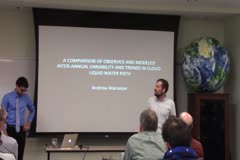
A Comparison of Observed and Modeled Inter-Annual Variability and Trends in Cloud Liquid Water Pah
December 10, 2015
Andrew Manaster
Long-term satellite records of changes in cloud properties have only been available for the past several decades and have just recently been used to help diagnose cloud-climate feedbacks. However, due to issues with satellite drift, calibration, and other artifacts, the validity of these changes in cloud properties has been called into question. It is therefore pertinent that we look for…
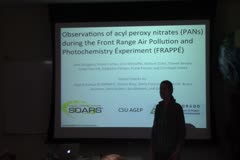
OBSERVATIONS OF ACYL PEROXY NITRATES DURING THE FRONT RANGE AIR POLLUTION AND PHOTOCHEMISTRY ÉXPERIMENT (FRAPPÉ)
December 09, 2015
Jake Zaragoza
The Colorado Front Range is an ozone (O3) nonattainment region. The photochemistry of the region is influenced by emissions from the urban sector, the oil and gas sector, the complex terrain and the meteorology. The Front Range Air Pollution and Photochemistry Éxperiment (FRAPPÉ) was a field intensive carried out in the Colorado Front Range during summer 2014 to characterize…
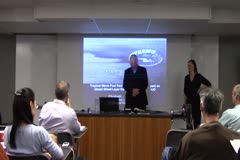
Tropical Warm Pool Rainfall Variability and Impact on Ocean Mixed Layer Depth throughout the MJO
December 09, 2015
Elizabeth Thompson
Heating and rain freshening often stabilize the upper tropical ocean, bringing the ocean mixed layer depth to the sea surface. These thin mixed layer depths concentrate subsequent fluxes of heat, momentum, and freshwater into a thin layer, promoting rapid SST heating that is important for atmospheric convection. Shallow mixed layers also inhibit wind-driven ocean mixing and entrainment cooling…
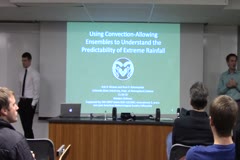
Using Convection-Allowing Ensembles to Understand the Predictability of Extreme Rainfall
November 23, 2015
Erik Nielsen
The meteorological community has well established the usefulness of ensemble-based numerical weather prediction for precipitation guidance, since trusting one possible atmospheric solution can lead to, in some cases, particularly bad forecasts for precipitation guidance, owing to inherent uncertainties in precipitation processes that make deterministic prediction impractical. However, continued…
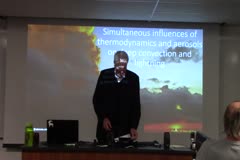
The Simultaneous Influence of Thermodynamics and Aerosols on Deep Convection and Lightning
November 20, 2015
Doug Stolz
The dissertation consists of a multi-scale investigation of the relative contributions of thermodynamics and aerosols to the observed variability of deep convective clouds in the Tropics. First, estimates of thermodynamic quantities and cloud-condensation nuclei (CCN) in the environment are attributed to convective features (CFs) observed by the Tropical Rainfall Measuring Mission (TRMM)…
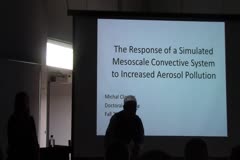
The Response of a Simulated Mesoscale Convective System to Increased Aerosol Pollution
November 19, 2015
Michal Clavner
Mesoscale Convective Systems (MCS) are important contributors to rainfall in the High Plains of the United States as well as producers of severe weather such as hail, tornados and straight-line wind events known as derechos. It is therefore of interest to understand how different aerosols serving as cloud condensation nuclei (CCN) concentrations may impact these systems. This work focuses on…
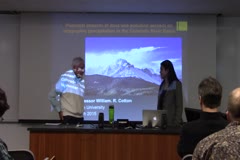
Examination of the Potential Impacts of Dust and Pollution Aerosol Acting as Cloud Nucleating Aerosol on Water Resources in the Colorado River Basin
November 18, 2015
Vandana Jha
The Southwest United States has huge demands on water resources. The Colorado River Basin (CRB) covers the states of Colorado, Wyoming, Utah, Nevada, Arizona, New Mexico, and California as well as Mexico and serves 27 million people. The clouds in the CRB are potentially affected by anthropogenic aerosol pollution and dust acting as cloud-nucleating aerosol as well as impacting snowpack albedo.…
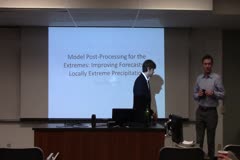
Model Post-Processing for the Extremes: Improving Forecasts of Locally Extreme Rainfall
November 16, 2015
Greg Herman
This study investigates the science of forecasting locally extreme precipitation events over the contiguous United States from a fixed-frequency perspective, as opposed to the traditionally applied fixed-quantity forecasting perspective. Frequencies are expressed in return periods, or recurrence intervals; return periods between 1-year and 100-years are analyzed for this study. Many different…
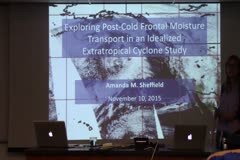
Exploring Post-Cold Frontal Moisture Transport in an Idealized Extratropical Cyclone Study
November 10, 2015
Amanda Sheffield
Moisture transport in extratropical cyclones (ETCs) has been studied in the past in the context of the warm conveyor belt (WCB), a 'conveyor belt' transferring moisture from the warm sector boundary layer to the free troposphere both eastward and poleward of the warm front. Recent research has highlighted a different, potentially important mechanism of transporting water vapor in ETCs by…
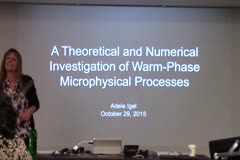
A Theoretical and Numerical Investigation of Warm-Phase Microphysical Processes
October 29, 2015
Adele Igel
Several studies examining microphysical processes are conducted with an emphasis on further understanding warm-phase processes, particularly condensation. In general, these studies progress from simple to complex representations of microphysical processes in models. In the first study, a theoretical, analytical expression for the condensational invigoration, that is the invigoration in the…
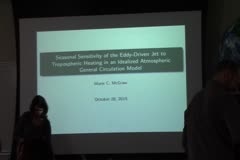
Seasonal Sensitivity of the Eddy-Driven Jet to Tropospheric Heating in an Idealized Atmospheric General Circulation Model
October 28, 2015
Marie McGraw
A dry dynamical core is used to investigate the seasonal sensitivity of the circulation to two idealized thermal forcings: a tropical upper tropospheric forcing, and a polar lower tropospheric forcing. The circulation is modified using a set of perpetual simulations to simulate each month of the year, while the thermal forcings are held constant. The circulation responses to tropical warming…
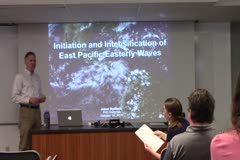
Initiation and Intensification of East Pacific Easterly Waves
October 14, 2015
Adam Rydbeck
The background atmospheric state of the east Pacific (EPAC) warm pool in which easterly waves (EWs) develop varies dramatically on intraseasonal time scales. EPAC intraseasonal variability is well known to modulate local convective and circulation patterns. Westerly intraseasonal phases are associated with westerly low-level wind and positive convective anomalies and easterly intraseasonal…
